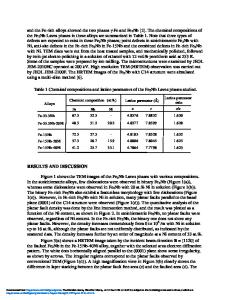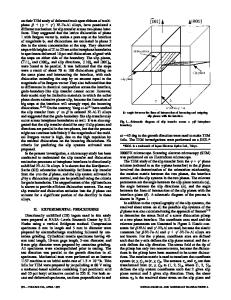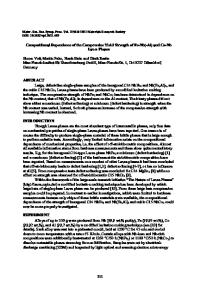Effect of Dislocation Sources on Slip in Fe 2 Nb Laves Phase with Ni in Solution
- PDF / 372,166 Bytes
- 6 Pages / 432 x 648 pts Page_size
- 61 Downloads / 341 Views
Effect of Dislocation Sources on Slip in Fe2Nb Laves Phase with Ni in Solution N. Takata 1, H. Ghassemi-Armaki 2, Y. Terada 1, M. Takeyama 1 and S. Kumar 2 Department of Metallurgy and Ceramics Science, Graduate School of Science and Engineering, Tokyo Institute of Technology, 2-12-1, Ookayama, Meguro-ku, Tokyo, 152-8552, Japan 2 School of Engineering, Brown University, Providence, RI 02912, U.S.A. 1
ABSTRACT We have examined the compression response of a ternary Fe2Nb Laves phase by deforming micropillars with a diameter of ~2 μm produced by focused ion beam milling from a two-phase Fe-15Nb-40Ni (at.%) ternary alloy consisting of the Laves phase and γ-Fe. The Laves phase micropillars exhibit high strength of about 6 GPa (of the order of the theoretical shear strength of the material), followed by a burst of plastic strain and shear failure on the basal plane. If dislocation sources are introduced on a non-basal plane in the micropillars by nanoindentation prior to compression, yielding occurs at a significantly lower stress level of about 3 GPa and plastic deformation by slip proceeds on a pyramidal plane close to (-1-122). Furthermore, if regenerative dislocation sources for basal slip are present in the micropillar, the Laves phase can be continuously plastically deformed in a stable manner to at least 5% strain at a significantly lower stress of 800 MPa. We thus demonstrate the plastic deformation of this ternary Laves phase at the micron-scale at room temperature when sufficient dislocation sources are present. INTRODUCTION Our extensive effort has revealed the phase equilibria between γ-Fe (fcc) and Fe2M Laves phase (C14) in Fe-M-Ni ternary systems (M: Nb, Ti, Mo) at elevated temperature [1-5], based on our design concept for the development of a new type of austenitic heat resistant steel strengthened by TCP (topologically close-packed) Fe2M Laves phase and GCP (geometrically close-packed) Ni3Mphase [6]. In Fe-Nb-Ni ternary system, the homogeneity region of Fe2Nb Laves phase extends towards the equi-Nb concentration direction up to 44 at.% Ni [1,2]. This indicates that more than two thirds of the Fe sublattice sites in Fe2Nb can be replaced by Ni atoms. The Fe-rich Fe2Nb Laves phase with over 30 at. %Ni in solution (in equilibrium with ȖFe) includes numerous basal planar faults extending to several micrometers [7]. One of the interesting findings in the Fe-Nb-Ni ternary Laves phase is that solute Ni atoms significantly soften the Fe-rich Laves phase [1]. This suggests that Ni in solution may enhance the plastic deformability of the Laves phase, resulting in solid solution softening. In this study, we have examined mechanical properties of the ternary Fe2Nb Laves phase (in equilibrium with Ȗ-Fe) by uniaxial compression of micropillars (~2 μm diameter) and demonstrate that in certain conditions, it is possible to obtain plastic deformation at this scale at room temperature. EXPERIMENTAL PROCEDURE In this study, Fe-15Nb-40Ni alloy (at.%) was prepared by arc-melting and equilibrated at 1473 K/240 h, followed by
Data Loading...










